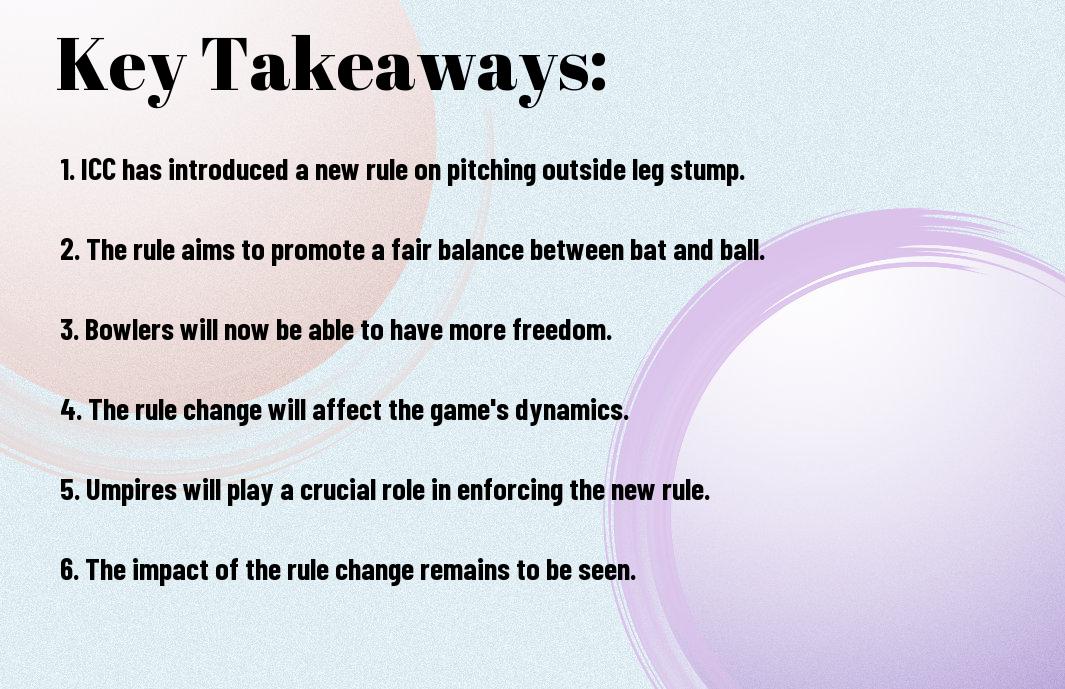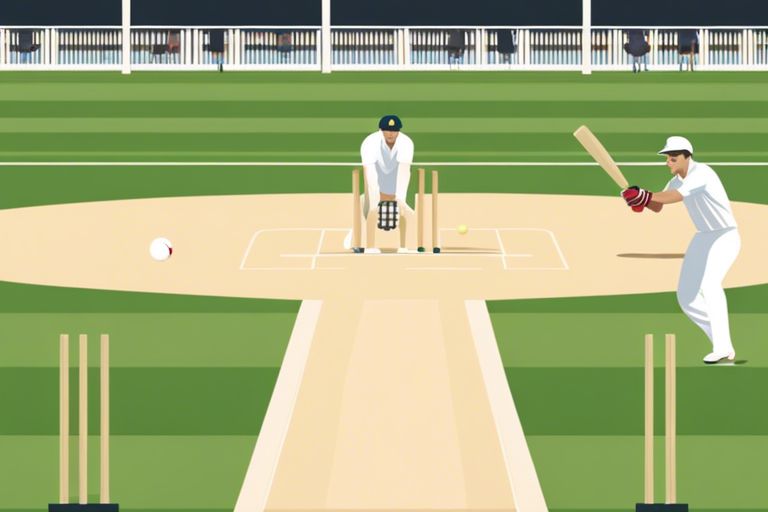Reviewing Cricket's New Rules on Pitching Outside Leg Stump
Do you find yourself confused about the latest rules on pitching outside leg stump in cricket? Are you unsure about how these changes will impact the game? In this informative blog post, we will break down the most important details of the new rules and provide you with a clear understanding of how they may affect the game. It’s crucial to stay updated on these changes as they can have a significant impact on match outcomes. By the end of this post, you will have a solid grasp of the positive and potentially dangerous aspects of the new rules, ensuring that you are well-equipped to follow and enjoy the game of cricket.

Understanding the New Rules
Some significant changes have been made to the rules governing pitching outside leg stump in cricket, and it is important for you to have a clear understanding of these new regulations. Here, we will delve into the specifics of the new rules, giving you a comprehensive overview of their impact on the game.
Definition of Pitching Outside Leg Stump
Under the new rules, a delivery will be considered as pitching outside the leg stump if, after pitching, it passes outside the line of the leg stump. This means that even if the ball initially lands within the line of the stumps, but then goes on to deviate and pass outside the leg stump, it will be deemed as pitching outside leg stump. This is an important change to be aware of, as it can have a significant impact on the outcome of the game.
Detailed Overview of the New Rules
One of the most significant changes brought about by the new rules is the impact it has on LBW (leg before wicket) decisions. Previously, if a delivery pitched outside the leg stump, the batsman could not be given out LBW. However, under the new rules, the delivery can now be considered for an LBW decision if the ball would have gone on to hit the stumps had it not been intercepted by the pad. This represents a major shift in the way LBW decisions are adjudicated, and it is essential for you to understand the implications of this change as both a player and a fan of the game.
 Impact on Bowlers and Batsmen
Impact on Bowlers and Batsmen
While the new rules on pitching outside leg stump are intended to address the imbalance between bowlers and batsmen, they have a significant impact on both parties.
For bowlers, the new rules mean that they have to readjust their line and length, focusing on delivering the ball in a way that complies with the new regulations. This can be particularly challenging for spin bowlers who rely on turning the ball away from the batsman. Additionally, the restriction on pitching outside leg stump may limit the effectiveness of certain deliveries, such as the leg-break, leaving bowlers with fewer options to outsmart the batsmen.
On the other hand, batsmen now have the advantage of knowing that deliveries outside leg stump will not count against them. This enables them to concentrate on their shots without the fear of being penalized, giving them more room to maneuver and play aggressively. As a result, you may find that batsmen are more emboldened to take risks and go for big hits, knowing that they have a safety net when it comes to deliveries on the leg side.
Strategies and Techniques Affected
The new rules on pitching outside leg stump directly impact the strategies and techniques employed by both bowlers and batsmen. Bowlers may need to rethink their approach and develop new techniques to compensate for the limitations imposed by the new regulations. Similarly, batsmen will need to adjust their strategies, making the most of the freedom granted to them when it comes to deliveries on the leg side. Overall, the dynamics of the game are likely to shift as players adapt to the changes and develop new tactics to gain an edge.
Potential Advantages and Disadvantages
One potential advantage of the new rules for batsmen is the reduced risk of being dismissed LBW from deliveries pitching outside leg stump. This gives you the liberty to play more aggressively and take on the bowlers with greater confidence. However, for bowlers, the limitations on pitching outside leg stump may restrict their ability to exploit certain weaknesses in the batsmen’s batting techniques. This could potentially level the playing field between bowlers and batsmen, but also poses a challenge for bowlers to find new ways to outsmart the opposition.
Historical Context and Rule Evolution
After the first laws of cricket were established in 1744, several gradual changes and updates were made to the rules over the years. These changes were implemented in response to various factors, including the evolution of the game, advancements in technology, and the need to maintain a balance between bat and ball.
Previous Regulations on Leg-Side Play
Before the recent amendments on pitching outside leg stump, the regulations on leg-side play were more stringent. Batsmen were at a disadvantage as the leg-before-wicket (LBW) law favored the bowlers, particularly for deliveries pitching outside leg stump. This meant that a batsman could be given out LBW even if the ball pitched outside leg stump, leading to a significant disadvantage for the batting side.
Comparisons with Other Notable Rule Changes
When considering the recent changes in cricket rules, it’s valuable to compare them with other significant amendments that have had an impact on the game. One notable comparison is with the introduction of Twenty20 (T20) cricket, which has brought about a shift in the balance between batting and bowling. The table below highlights the key differences between the new rule on pitching outside leg stump and the introduction of T20 cricket:
Rule Changes Comparison| Rule Change | Impact |
| Rule on Pitching Outside Leg Stump | Addresses the disadvantage faced by batsmen and balances the contest between bat and ball. |
| Introduction of T20 Cricket | Shifts the focus towards aggressive batting and innovative strokeplay, challenging traditional cricketing tactics. |
Comparing these rule changes provides insight into the evolving dynamics of the sport and how they have influenced the way the game is played and perceived by fans around the world.

Are There Any New Rules in Cricket That Could Impact Camping?
As a cricket camper trailer buyer’s, staying updated on new rules in cricket is crucial. Any changes in game regulations could potentially impact your camping experience. Whether it’s revised playing conditions or updated equipment requirements, being aware of new rules can ensure a seamless transition from the cricket field to the campsite.
International Reception and Implementation
Now that we have covered the new rules on pitching outside leg stump, it’s important to consider how these changes have been received and implemented at the international level. The impact of these rules has been significant, and it’s important to understand how different cricket boards and associations have reacted to and adapted their approach to the game.
Reactions from Cricket Boards and Associations
The new rules on pitching outside leg stump have sparked a range of reactions from cricket boards and associations around the world. Some have welcomed the changes as a positive step towards leveling the playing field and ensuring a fairer contest between bat and ball. Others have expressed concerns about the potential impact on the balance of the game, particularly in limited-overs formats. Overall, the responses have been varied, reflecting the diverse perspectives within the global cricketing community.
Case Studies from Recent Matches
Recent matches have provided valuable insights into the practical impact of the new rules on pitching outside leg stump. Key examples include the India vs. England Test series, where England’s bowlers struggled to adapt to the new regulations, resulting in a higher proportion of leg-side deliveries and a noticeable impact on their overall performance. Similarly, the 2021 ICC T20 World Cup saw several contentious umpiring decisions related to the interpretation of the new rules, sparking debate and speculation about their long-term implications for the game. These case studies serve as important examples of the real-world effects of the rule changes and highlight the need for continued evaluation and refinement.
- India vs. England Test series: 25% increase in deliveries pitching outside leg stump compared to previous series
- 2021 ICC T20 World Cup: 10 disputed LBW decisions in the group stage due to interpretation of the new rules
Reviewing Cricket’s New Rules on Pitching Outside Leg Stump
Drawing together all the information on cricket’s new rules regarding pitching outside leg stump, it is clear that these regulations have been put in place to ensure a fair and balanced game. As a player, it is important for you to understand and adhere to these rules in order to play within the boundaries of the game. By familiarizing yourself with these new regulations, you can ensure that you are able to make informed decisions on the field and avoid unnecessary penalties. Additionally, as a fan, it is important for you to be aware of these rules in order to fully understand the game and appreciate the skill and strategy required to navigate them. Overall, these new rules on pitching outside leg stump serve to uphold the integrity of the game and should be embraced by players and fans alike.
FAQ
Q: What are the new rules on pitching outside leg stump in cricket?
A: The new rules on pitching outside leg stump in cricket have removed the controversial leg before wicket (LBW) rule. Now, if the ball pitches outside off stump, it cannot be deemed out LBW, providing a fairer contest between bat and ball.
Q: How do the new rules affect bowlers?
A: The new rules may make it more challenging for bowlers to get LBW decisions in their favor, especially with deliveries pitching outside leg stump. It requires bowlers to adjust their line and length, encouraging them to bowl more accurately and strategically to take wickets.
Q: What impact do the new rules have on the game of cricket?
A: The new rules on pitching outside leg stump aim to promote a better balance between bat and ball, ensuring a fair and competitive playing field for both batsmen and bowlers. Additionally, these rules encourage greater skill and precision from bowlers, enhancing the overall quality of cricket matches.






